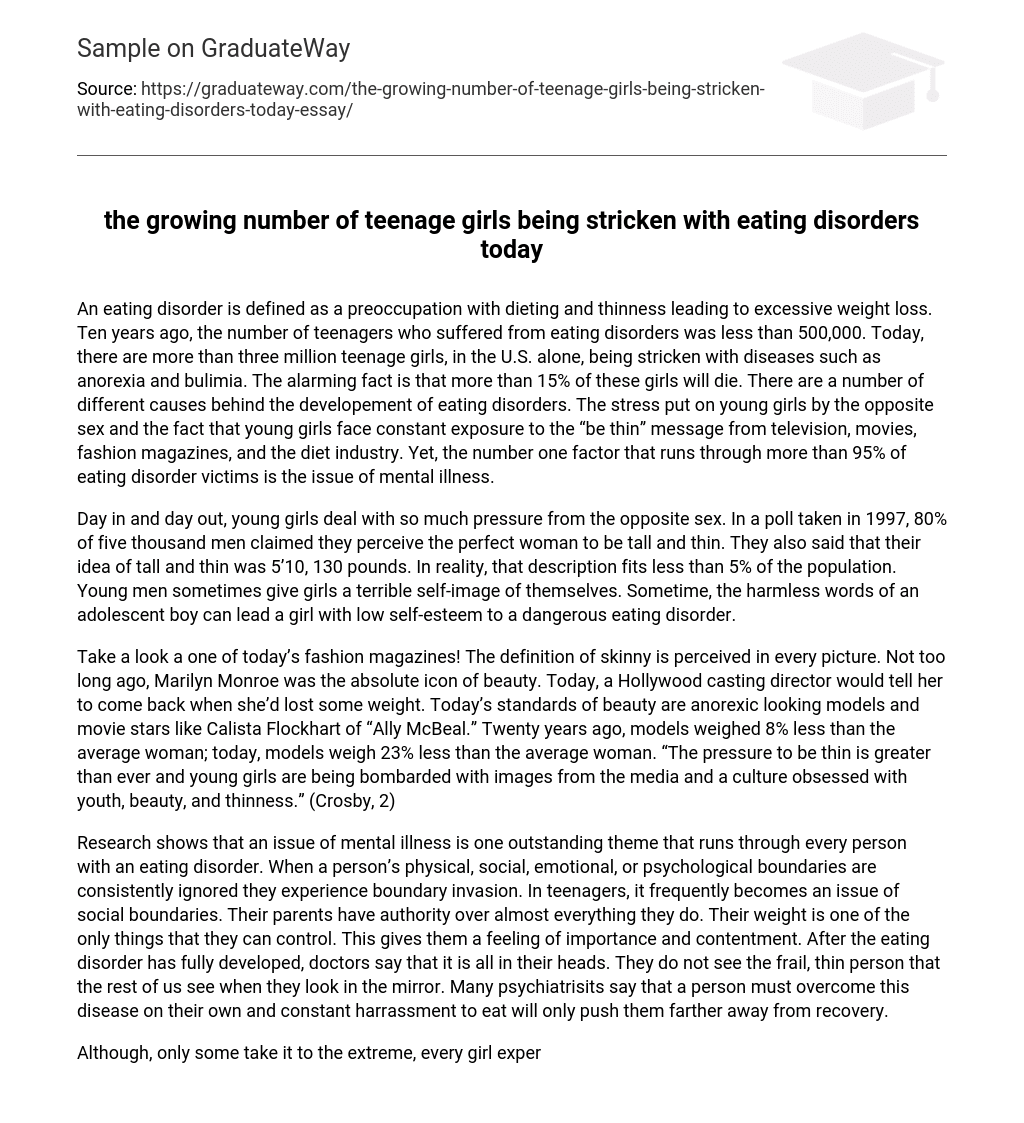An eating disorder refers to when someone becomes excessively focused on dieting and maintaining a slim figure, resulting in significant weight loss. Previously, less than 500,000 teenagers were affected by these disorders. However, currently in the United States alone, more than three million teenage girls suffer from illnesses like anorexia and bulimia. Shockingly, over 15% of these girls will lose their lives due to these conditions. Various factors contribute to the development of eating disorders including societal pressure for young girls to be thin through media sources such as TV shows, movies, fashion magazines, and the diet industry. Nonetheless, mental illness accounts for over 95% of cases involving eating disorders.
Every day, young girls face immense pressure from boys. Research conducted in 1997 found that 80% of five thousand men believed the ideal woman should possess a height and weight defined as being 5’10 and weighing 130 pounds, which only less than 5% of people actually meet. These unattainable standards imposed by young men can have a detrimental impact on a girl’s self-perception. In fact, even innocent comments made by teenage boys have the potential to push a girl with low self-esteem towards developing an unhealthy eating disorder.
Today’s fashion magazines depict a perception of skinny in every picture, contrasting with Marilyn Monroe, who was once considered the epitome of beauty. Nowadays, a Hollywood casting director would dismiss her unless she shed some weight. Today’s beauty standards revolve around anorexic-looking models and Hollywood stars like Calista Flockhart from “Ally McBeal.” In comparison to twenty years ago, models now weigh 23% less than the average woman, while back then they only weighed 8% less. The current pressure to be thin is exceptionally high, leading young girls to be bombarded with media images and a culture fixated on youth, beauty, and thinness.” (Crosby, 2)
Research shows that mental illness is a common factor in individuals with eating disorders. The constant disregard of physical, social, emotional, or psychological boundaries can lead to boundary invasion, especially among teenagers who often struggle with social boundaries. While parents have control over many aspects of their lives, weight is one area that teenagers feel they can personally manage. This gives them a sense of importance and satisfaction. However, once the eating disorder is fully developed, doctors often view it as solely a psychological condition and fail to see the frail and thin individual that others see when the person looks in the mirror. Psychiatrists stress that individuals must overcome this disease independently and persistent pressure to eat will only impede their recovery process.
Weight-related issues are common among girls, although not all experience them to the extreme. It is important to identify signs of an eating disorder, such as a focus on food and dieting, excessive exercise, low self-esteem, and feelings of depression and moodiness. This illness does not simply disappear over time; only three out of five girls will recover from it. Unfortunately, there is no cure for this deadly disease like there is for cancer and AIDS. As Crosby stated (3), teenage girls must go beyond their physical appearance and learn to love themselves for who they truly are instead of their outward appearance.
The Eating Disorder Sourcebook: A comprehensive guide to the causes, treatments, and prevention of eating disorders
was authored by Carolyn Costin. This is the second edition of the book published by Lowell House in 1999.
2. Moe, Barbara. Understanding Negative Body Image (Teen Eating Disorder Prevention Book). Rosen Publishing, 1999, 1st edition.
3. Crosby, Johanna. “You Can Be Too Thin: Society shapes girls’ body images- in dangerous ways.” Cape Cod Times, March 11, 1999.





